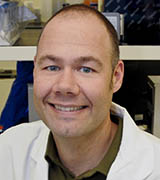Colleagues: Recently Tenured
DANIEL BARBER, PH.D., NIAID
Senior Investigator, T-Lymphocyte Biology Section, Laboratory of Parasitic Diseases, National Institute of Allergy and Infectious Diseases

Education: Rider University, Lawrenceville, New Jersey (B.S. in biochemistry); Emory University, Atlanta (Ph.D. in microbiology and immunology)
Training: Postdoctoral fellow and research fellow, Immunobiology Section, Laboratory of Parasitic Diseases, NIAID
Came to NIH: In 2006 for training; became Earl Stadtman tenure-track investigator in 2012
Outside interests: Motorcycling; collecting fountain pens
Website: https://irp.nih.gov/pi/daniel-barber
Research interests: My lab’s major intertest is in the CD4 T-cell response against Mycobacterium tuberculosis (Mtb) infection, the leading cause of infectious-disease death worldwide. CD4 T cells are critical for the control of Mtb, but they also drive tissue damage. We don’t know exactly how they do either. Our goal is to identify the protective mechanisms of CD4 T cells and to understand the immunoregulatory molecules that prevent T-cell-mediated immunopathology in mice, nonhuman primates, and humans.
Early in my career, I led a study that defined a new and critical role for the inhibitory pathway of programmed cell death protein 1 (PD-1)—which was known to regulate immune responses to self-antigens—in modulating T-cell function during chronic viral infection. (Nature 439:682–687, 2006; DOI:10.1038/nature04444)
While at the NIH, I have shown that PD-1 is required to prevent CD4 T-cell-driven fatal disease during Mtb infection. The findings may have major implications for individuals being treated with PD-1–targeting drugs as cancer immunotherapy. My lab and I are investigating the mechanisms of immunopathology in this setting in both mice and nonhuman primates.
Our other major interest is in the mechanisms of immune protection against Mtb infection. We have shown that only a specific subset of CD4 T cells can migrate to the lungs and protect, and we are working to understand the cues that drive the generation of these protective T cells. We are also trying to identify novel T-cell-derived effector molecules that are required for the control of Mtb infection.
For example, my lab has shown that CD153 (expressed by CD4 T cells) is required for the control of Mtb infection, and we are currently studying the mechanisms of this novel antitubercular axis.
MICHAEL B. COOK, PH.D., NCI-DCEG
Senior Investigator, Metabolic Epidemiology Branch, Division of Cancer Epidemiology and Genetics, National Cancer Institute

Education: University of Nottingham, Nottingham, England (B.Sc. in genetics); University of Leeds, Leeds, England (Ph.D. in epidemiology)
Training: Postdoctoral fellow and research fellow, NCI-DCEG
Came to NIH: In 2007 for training; became a tenure-track investigator in 2011
Outside interests: Spending time with his wife and daughter; playing golf; cycling; camping; brewing beer
Website: https://irp.nih.gov/pi/michael-cook
Research interests: I am interested in the epidemiology and pathogenesis of esophageal adenocarcinoma and prostate cancer.
Esophageal adenocarcinoma has dramatically increased in the United States. Although we understand that gastroesophageal reflux disease promotes the development of esophageal metaplasia (Barrett’s esophagus), which increases the risk of esophageal adenocarcinoma, there is much to be learned. I am using both classical and molecular epidemiological approaches to better understand 1) the pathogenesis and progression of this disease; 2) how obesity is associated with an increased risk of this malignancy; 3) why Barrett’s esophagus and esophageal adenocarcinoma are more prevalent in men than in women; and 4) what biomarkers can be used for diagnosis and risk prediction. I am pursuing studies of sex-steroid hormones, systemic inflammation, microRNAs, and other circulating and tissue-based markers to answer these questions. My hope is that we can develop evidence-based primary and secondary interventions to prevent esophageal cancer as well as diagnose this malignancy at earlier stages.
I am also studying prostate cancer to explain its etiology and discover prognostic biomarkers that can help predict the course of disease. I am trying to 1) describe and understand the basis of racial differences in prostate cancer; 2) understand the etiologic roles of sex steroid hormones and reproductive factors; and 3) discover and validate tissue biomarkers that will help predict whether the malignancy is indolent or aggressive. In addition, I am assessing whether computational-pathology algorithms of prostate biopsy or radical prostatectomy samples may improve diagnostic and prognostic algorithms of prostate cancer.
PAMELA GUERRERIO, M.D., PH.D., NIAID
Senior Investigator and Chief, Food Allergy Research Unit, Laboratory of Allergic Diseases, National Institute of Allergy and Infectious Diseases

Education: University of Iowa, Iowa City, Iowa (B.S. in biology); Johns Hopkins School of Medicine, Baltimore (Ph.D. in human genetics; M.D.)
Training: Residency in pediatrics and fellowship in pediatric allergy and immunology, Johns Hopkins Hospital (Baltimore)
Before coming to NIH: Assistant professor, Pediatric Allergy and Immunology, Johns Hopkins Hospital
Came to NIH: In 2014
Outside interests: Running; hiking; biking; engaging in other outdoor activities
Website: https://irp.nih.gov/pi/pamela-guerrerio
Research interests: My group aims to understand the key genetic, immunologic, and biochemical pathways that lead to the development of food allergies and how they can be manipulated for therapeutic benefit. We are using a multifaceted approach involving both patients and mouse models. Our current focus is on genetic diseases associated with food allergies and other allergies; environmental and immunologic factors that influence the development and severity of food allergies; and novel therapies for the prevention and treatment of these allergies.
In our genetic research, we have recently shown that patients with the connective-tissue disorder Loeys-Dietz syndrome (LDS) caused by mutations in genes encoding the receptor for transforming growth factor beta exhibit a high prevalence of food allergy, asthma, eosinophilic esophagitis (a chronic, allergic inflammatory disease of the esophagus), and other allergic conditions. By studying LDS and other genetic disorders that predispose one to food allergies, we can achieve greater insight into the key cellular and signaling pathways that regulate allergic inflammation. This information may have tremendous therapeutic implications for those who suffer from allergic diseases.
We are also investigating how genetic and environmental factors may interact in the development of food allergies. Why do some patients who have immunoglobulin E antibodies to foods experience an allergic reaction when they eat the food while others don’t? We are also identifying immunologic markers that can predict the severity and persistence of food allergies.
By achieving a greater understanding of the key environmental, immunologic, and biochemical pathways that drive the development of food allergies, we will be able to develop novel interventions that are based on a refined understanding of disease pathogenesis.
VINCENT MUNSTER, PH.D., NIAID
Senior Investigator and Chief, Virus Ecology Unit, Laboratory of Virology, Rocky Mountain Laboratories, National Institute of Allergy and Infectious Diseases

Education: Utrecht University in Utrecht, Netherlands (M.Sc. in molecular biology); Erasmus University Rotterdam, in Rotterdam, Netherlands (Ph.D. in virology)
Training: Postdoctoral research fellow in virology at Erasmus Medical Center (Rotterdam); postdoctoral fellow in disease modeling and transmission, Laboratory of Virology, NIAID’s Rocky Mountain Laboratories
Came to NIH: In 2009 for training; in 2013, established the Virus Ecology Unit as an independent tenure-track investigator
Outside interests: Cycling; skiing; hiking; wildlife; triathlons; cooking; reading; traveling; and gardening
Website: https://irp.nih.gov/pi/vincent-munster
Research interests: Emerging viral diseases—such as the Ebola virus, Middle East respiratory syndrome coronavirus (MERS-CoV), and the new coronavirus (COVID-19) that emerged in China in 2019—are a major challenge to public health. We know very little about the origin of these viruses and how they interact with their natural hosts (fruit bats for Ebola; dromedary camels for MERS-CoV; likely bats and pangolins for COVID-19) or how genetic or ecological changes (such as deforestation and climate change) would increase the frequency of outbreaks in humans.
To enhance our understanding of what drives pathogen spillover from animals to humans, my lab is combining field research in places where these outbreaks occur (in the Republic of the Congo for Ebola and Jordan for MERS-CoV) with controlled experiments in the lab. In the Republic of the Congo, we are collaborating with the Wildlife Conservation Society and the Laboratoire National de Santé Publique in Brazzaville (the capital of the Republic of the Congo) to conduct field studies on Ebola. We are doing long-term studies on the role of fruit bats in Ebola virus spillover to humans. We are also strengthening the diagnostic capacity for these pathogens to ensure rapid and safe detection. In Jordan, we trying to understand the risk factors associated with MERS-CoV transmission by looking at the human-animal interface between camel herders and the dromedary camels.
In the lab, we try to link the information obtained in the field with detailed experimental studies on the mechanisms of pathogenicity and transmission. We are also working with several academic and industry partners to develop vaccines against MERS-CoV as well as against two other zoonotic viruses—Nipah virus and Lassa virus. As of January 2020, my lab has become directly involved in NIAID’s response against the newly emerged 2019-NCoV; we are focusing on the rapid development of diagnostics, vaccines, and antivirals.
ADAM PHILLIPPY, PH.D., NHGRI
Senior Investigator and Head, Genome Informatics Section, Computational and Statistical Genomics Branch, National Human Genome Research Institute

Education: Loyola University, Baltimore (B.S. in computer science); University of Maryland, College Park, Maryland (M.S. and Ph.D. in computer science)
Before coming to NIH: Senior principal investigator, Genomics, National Biodefense Analysis and Countermeasures Center (Frederick, Maryland)
Came to NIH: In 2015
Outside interests: Practicing lacrosse with his younger daughter; going to horse trials with his older daughter; spending time with his wife and family; and mountain biking solo
Website: https://irp.nih.gov/pi/adam-phillippy
Research interests: The Genome Informatics Section develops and applies computational methods for the analysis of massive genomic datasets with a focus on the challenges of genome sequencing and comparative genomics. For example, reference genomes are the foundation of all genomic research, but sequencing and assembling a genome is a difficult process that can leave many gaps and errors that, in turn, affect the accuracy of downstream analyses. To this day, even the human reference genome remains unfinished and incomplete. My research aims to improve such foundational processes and translate emerging genomic technologies into practice.
My past experience includes developing novel sequence-analysis methods that were essential for the FBI’s investigation of the 2001 anthrax letter mailings, and later founding a bioinformatics group—for the genomic investigation of biocrimes—at the National Biodefense Analysis and Countermeasures Center at Fort Detrick (Frederick, Maryland). My group has since developed high-impact bioinformatics tools and pioneered the use of single-molecule and nanopore sequencing for the automated reconstruction of complete genomes. Most recently, we released the first complete sequence of an entire human X chromosome, and we aim to finish sequencing the remaining chromosomes within the next few years.
Recent sequencing-technology advances also create an enormous opportunity to combat infectious disease. As sequencing technologies become smaller and more affordable, clinical and environmental pathogen sequencing will become routine, generating millions of microbial genomes. We aim to develop computational methods that will enable this new scale of data sharing and analysis, ultimately forming a worldwide sensor network of genomic data that can inform outbreak detection and response.
This page was last updated on Thursday, March 24, 2022
